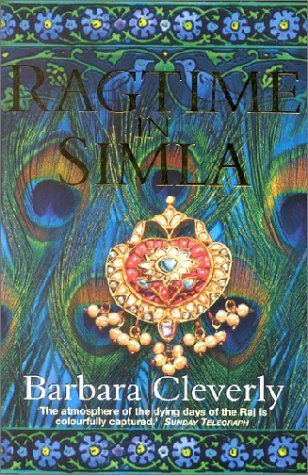 These books by British writer Barbara Cleverly form a murder mystery series. Although I have read other serial fiction and other murder mysteries, this is my first encounter with this particular combination. I found the first two books in a recent remainder catalog at prices much reduced from their original suggested retails. They were sufficiently enjoyable to prompt me to seek out the next two, which are readily available from the usual on-line sources. They are probably also available in the mystery section of any relatively large bricks-and-mortar bookstore, if you prefer to shop that way. They all run about 300 pages in length and are relatively quick reads — probably good fare for summer travel.
These books by British writer Barbara Cleverly form a murder mystery series. Although I have read other serial fiction and other murder mysteries, this is my first encounter with this particular combination. I found the first two books in a recent remainder catalog at prices much reduced from their original suggested retails. They were sufficiently enjoyable to prompt me to seek out the next two, which are readily available from the usual on-line sources. They are probably also available in the mystery section of any relatively large bricks-and-mortar bookstore, if you prefer to shop that way. They all run about 300 pages in length and are relatively quick reads — probably good fare for summer travel.
All of the stories take place in the early 1920s; in fact, the time period starts to get a bit compressed, with multiple stories apparently taking place during the same few months in 1922, as I shall explain below. All of them are set in and around Calcutta, India. Particularly in terms of the ever-present tensions between the British and their Indian ‘subjects’, this period and setting give the books quite a lot of common ground with both E. M. Forster’s A Passage to India and Paul Scott’s Raj Quartet.
 As the star of the series, Cleverly has created Commander Joe Sandilands of London’s Metropolitan Police. This character appears to be based in part on Cleverly’s great uncle, Harold Richard Sandilands, to whom she dedicates The Damascened Blade. Joe Sandilands is a World War I veteran who entered into police work as a natural progression from military intelligence service. He is tall and good-looking except for a battle scar over one eyebrow that pulls his face into a permanent quizzical expression. He’s also single, which leaves him free to form occasional liaisons with interesting ladies along the way. Unlike many protagonists in this genre, Sandilands doesn’t have any significant vices or idiosyncrasies. He’s actually a pretty likable guy.
As the star of the series, Cleverly has created Commander Joe Sandilands of London’s Metropolitan Police. This character appears to be based in part on Cleverly’s great uncle, Harold Richard Sandilands, to whom she dedicates The Damascened Blade. Joe Sandilands is a World War I veteran who entered into police work as a natural progression from military intelligence service. He is tall and good-looking except for a battle scar over one eyebrow that pulls his face into a permanent quizzical expression. He’s also single, which leaves him free to form occasional liaisons with interesting ladies along the way. Unlike many protagonists in this genre, Sandilands doesn’t have any significant vices or idiosyncrasies. He’s actually a pretty likable guy.
At the start of the series, Sandilands has been on temporary assignment to the Bengal Police for about six months, assisting them withdeveloping better protocols for gathering and using forensic evidence. While in India, Sandilands has given a few public lectures on criminal investigation techniques. He is just packing to return to England when he gets a message from the Acting Governor of Bengal, Sir George Jardine, requesting his assistance with a murder investigation. Although they have not previously met, Sir George knows of Joe by reputation. Besides Joe, Sir George is the only character consistently present in all of the novels. Wealthy, politically powerful and devious, he keeps Joe involved in various criminal investigations and providing him with clues and collaborators and cover stories.
 The Last Kashmiri Rose is the first novel in the series and in the story of Joe Sandilands. According to the flyleaf, it’s also Cleverly’s first novel, written as a result of her winning entry in the Debut Dagger competition sponsored by the Crime Writers’ Association of Great Britain. Like any pilot, it introduces Joe, tells the reader a bit about his background, and establishes the premise for the series — Joe’s assignment to Calcutta and Sir George’s invitation to investigate a crime. The primary action of this novel takes place at a military and government base in Panikhat, about fifty miles south of Calcutta, where an officer’s wife has just been murdered in a rather horrific way. Joe quickly learns that this murder is only the latest in a series of similar crimes that began in 1910 with the death of another officer’s wife in a terrible house fire. Cleverly actually starts her narrative with a brief telling of the events surrounding that incident. This is a strategy she utilizes as well in subsequent novels in the series. For this adventure, Joe has two companions. Nancy Drummond is Sir George’s niece, an intelligent, resourceful and attractive young woman who is married to one of the high-ranking government officials on the base. Naurung Singh is a young Sikh officer who is assigned to work with Joe on the investigation. The narrative throughout this novel is in third person, almost entirely from Sandiland’s perspective as he assembles the pieces of the mystery into a coherent pattern.
The Last Kashmiri Rose is the first novel in the series and in the story of Joe Sandilands. According to the flyleaf, it’s also Cleverly’s first novel, written as a result of her winning entry in the Debut Dagger competition sponsored by the Crime Writers’ Association of Great Britain. Like any pilot, it introduces Joe, tells the reader a bit about his background, and establishes the premise for the series — Joe’s assignment to Calcutta and Sir George’s invitation to investigate a crime. The primary action of this novel takes place at a military and government base in Panikhat, about fifty miles south of Calcutta, where an officer’s wife has just been murdered in a rather horrific way. Joe quickly learns that this murder is only the latest in a series of similar crimes that began in 1910 with the death of another officer’s wife in a terrible house fire. Cleverly actually starts her narrative with a brief telling of the events surrounding that incident. This is a strategy she utilizes as well in subsequent novels in the series. For this adventure, Joe has two companions. Nancy Drummond is Sir George’s niece, an intelligent, resourceful and attractive young woman who is married to one of the high-ranking government officials on the base. Naurung Singh is a young Sikh officer who is assigned to work with Joe on the investigation. The narrative throughout this novel is in third person, almost entirely from Sandiland’s perspective as he assembles the pieces of the mystery into a coherent pattern.
Ragtime in Simla picks up quite nicely where The Last Kashmiri Rose ends, toward the end of March 1922. After the opening chapter sets the stage, so to speak, for the mystery, we find our hero Joe Sandilands on a train bound for Simla, the mountain town that the British apparently used as their summer capital during their occupation of India. The premise is that Joe is taking a month’s leave as Sir George’s guest after his successful efforts to solve the Panikhat murder mystery-but his expectations of recreation and relaxation are quickly dashed by a murder that takes place in his presence on the last leg of the journey upland. Simla is a small town full of ruling elites who don’t like to be bothered. Joe’s sidekick in this novel is Simla’s Police Superintendent Charlie Carter, who graciously accepts Joe’s participation in the investigation. Because Sir George is in residence in Simla, he gets more directly involved in this pursuit than he did the one in Panikhat. The team soon discovers that this murder may be linked to another one that took place at the same location just a year before.
The last three chapters of Ragtime in Simla find Joe on board a French steamer bound for  Marseilles in the company of three women who were all involved, one way or another, in the Simla murders. He is very obviously — and happily — headed back to England. Imagine my surprise when I started The Damascened Blade, which takes place in April 1922, and discovered Joe visiting an old war buddy at Gor Khatri, a military installation just outside Peshawar in India’s North-West Frontier (now part of Pakistan)! In conversation, characters in The Damascened Blade refer to the two cases featured in the earlier novels, so I can’t presume they never happened. I am not at all sure what Cleverly and her editor(s) were thinking, but the confusion of dates and locations across the novels really threw me for a loop! I think there are quite a few ways that she might have finessed her narratives to avoid this continuity gap.
Marseilles in the company of three women who were all involved, one way or another, in the Simla murders. He is very obviously — and happily — headed back to England. Imagine my surprise when I started The Damascened Blade, which takes place in April 1922, and discovered Joe visiting an old war buddy at Gor Khatri, a military installation just outside Peshawar in India’s North-West Frontier (now part of Pakistan)! In conversation, characters in The Damascened Blade refer to the two cases featured in the earlier novels, so I can’t presume they never happened. I am not at all sure what Cleverly and her editor(s) were thinking, but the confusion of dates and locations across the novels really threw me for a loop! I think there are quite a few ways that she might have finessed her narratives to avoid this continuity gap.
The premise of The Damascened Blade is that Sir George needs someone he can trust to look after an American heiress, Lily Coblenz, an energetic young woman who finds the social life in Simla rather dull and wants to see the ‘real’ India. Lily has a chance to travel to Gor Khatri with Grace Holbrook, a medical doctor on her way to Afghanistan. Since Joe is already there, he is Sir George’s obvious choice to keep Lily from getting into too much trouble. When Zeman Khan, the Afghani elite charged with escorting Dr. Holbrook to her destination, is found dead under very suspicious circumstances, Lily turns out to be a better sidekick than one might expect, until she disappears. In The Damascened Blade, Cleverly retains the flashback opening chapter that provides a clue to the mystery — but she changes her narrative style, adopting multiple viewpoints in order to tell parts of the story before Joe knows what’s going on.
I will admit that I was starting to find this series just a bit tedious by the time I opened The Palace Tiger. In this tale, which takes place in May and June 1922, Sir George dispatches Joe and another of his operatives, Edgar Troop (a grizzled old mercenary who also appeared in Ragtime in Simla) to the Princely State of Ranipur. Their assignment is to help out an old friend of Sir George’s, a dying maharajah who is having succession problems because his sons keep getting killed. Here, the opening chapter takes place only a short time before the primary action and shows a tiger killing a young peasant girl working in the field with her mother. This so-called ‘man-eating’ tiger becomes the focus of a hunting expedition that proves instrumental in the resolution of the mystery surrounding the deaths of the maharajah’s sons. This novel makes brief reference to The Damascened Blade and to Nancy and Charlie, Joe’s sidekicks in The Last Kashmiri Rose and Ragtime in Simla respectively, but otherwise seems to be very nearly a stand-alone in terms of Joe’s experiences and development.
As you can easily surmise from the publication dates on these four novels, Cleverly seems bent on delivering a new installment in this series every year. I have already ordered #5, The Bee’s Kiss, due out in June 2006. According to the advance notices, this one takes place in London in 1926. I am hoping it brings back some of the fun of the first two novels in the series.
(Carroll & Graf Publishers, 2002 to 2005)
